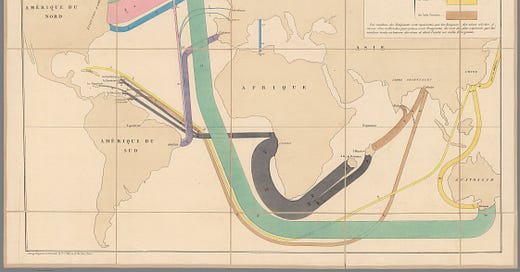Charles Joseph Minard’s map shows global emigration in 1858. It highlights an interesting demographic period after the abolition of slavery in Britain (1838) and France (1848), creating a dearth of workers in European colonies.
The black lines: coming out of Congo to Mauritius and La Reunion show the passage of workers from Africa to work on the sugar plantations owned by the French.
The Brown lines: Show the influx of indentured labourers from French settlements in Tamil Nadu in India, to fill the void created by the end of slavery. A substantial number of African and Indian migrants also make their way to the West Indies.
The Blue line across the Mediterranean shows French migration to Algeria, one of its richest colonies.
The thick green lines dominating the map show the huge wave of immigration from Britain to America, Canada and Australia; Australia became particularly attractive to prospective settlers after gold was found there. The number of British emigrants to America, however, was dwarfed by the number of Germans; in the period 1840-80, they made up the largest percentage of American immigrants.
The pink line representing them comes out of the major port cities Hamburg and Bremen. Hamburg was the home of the Hamburg-America line, the largest transatlantic shipping company of its time. Migration was motivated by economic prospects and after the 1848 revolutions in some German states, there was also a wave of political refugees fleeing to North America.
The purple line: Brazil gained independence from Portugal in 1822, but immigration there from Portugal actually increased after it stopped being a colony, mainly peasants from rural areas. There was also a substantial minority of immigrants from Germany, to the point that Prussia banned immigration to Brazil in 1859 after reports of ill treatment on coffee plantations.
The yellow line: China became an important source of labour in the mid-eighteenth century. The southern areas of the country suffered from political and economic instability, thanks to the weakness of the ruling Qing dynasty and the ongoing Opium Wars with the British. Chinese immigration to Cuba began in 1847 after the abolition of slavery; the Spanish replaced African slaves with Chinese indentured labour. Similarly, Chinese workers were often shipped under contract by agents to California during the Gold Rush, where they faced harsh working conditions and routine violence. The Chinese population in Australia, also spurred by the Gold Rush, grew large enough for the government to initiate anti-Chinese legislation.
Charles Joseph Minard (1781-1870) was a true pioneer in thematic cartography and in statistical graphics. He began as a civil engineer, and by 1810 was working on behalf of the French government in Antwerp and Vlissingen. Minard went on to have a long and productive career, working on projects throughout Europe, and was named Superintendent of the School of Bridges and Roads in France in 1830. Six years later, he became Inspector of the Corps of Bridges. In 1851, he took mandatory retirement, although still working in an advisory capacity, and undertook private research.
This is when his cartographical career began in earnest. He created 56 statistical maps over his lifetime, the most famous of which was the 'Map of Napoleon's Disastrous Russian Campaign of 1812', showing the losses suffered by Napoleon's army during his failed invasion of Russia.
Minard's genius lay in his realization that maps could provide visually clear renditions of complicated statistics. He wrote that the aim of his work was not to convey statistical results, but to show the relations between them, which would otherwise have to be worked out by the reader. He would often alter geographical reality on a map in order to make a diagram clearer, and so added the term 'approximative' to the title of his works to explain his decision.
He was possibly the first to use the flow-map technique (his writing indicates that he believed he had invented it) and he was certainly the first to use pie charts on a map. The importance of Minard's work was quickly recognized by the French government. He was awarded the Legion d'Honneur, and throughout the 1850s all Ministers of Public Works in France had their portrait painted with a Minard chart in the background. In 1861, his work was presented to Napoleon III. Minard's maps were not widely known in his lifetime outside of the intelligentsia and upper levels of government, suggesting that he published them privately. ~ David Rumsey Map Collection
Author: Charles Joseph Minard, 1781-1870
Date: 1858
Short Title:Carte figurative...1858 les émigrants du globe
Publisher: Regnier et Dourdet
Publisher Location: Paris





